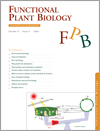
Functional Plant Biology
Volume 47 Number 3 2020
FP19225Research advances of WRINKLED1 (WRI1) in plants
WRINKLED 1 (WRI1) is an AP2/ERBP transcription factors, but previous work on its function has not been systematical. In this review, we systematically summarise the structure of WRI1, the molecular interactions during transcription and translation in plants. At the same time, we elucidated the genetic evolution and regulatory functions of WRI1 at the molecular level. Furthermore, we described a new pathway involving WRI1 that can be used to produce triacylglycerols (TAGs) in plants.
Exposure of plants to various stresses can negatively impact growth and eventually yield. Plants are equipped with protective mechanisms against stresses and we examined the involvement of a transmembrane cysteine-rich short protein in the protection response. We found that mutating the genes encoding such two proteins hampered growth mainly under heat stress and also under UV and concluded that proteins of only 72 amino acids protect plants from an increase in reactive oxygen species, occurring following exposure to heat.
FP18336Large-scale stage-specific regulation of gene expression during host–pathogen interactions in CSP44 bread wheat carrying APR gene Lr48
 and Kumble Vinod Prabhu
and Kumble Vinod Prabhu
Leaf rust causes major yield losses in wheat, which is the third most important grain crop worldwide. Using transcriptomics approach, we studied the molecular mechanism of leaf rust resistance due to adult plant resistance (APR) gene Lr48. Some important genes involved in disease resistance, identified during the present study, may prove useful in breeding for APR against leaf rust in wheat.
FP19053Contributions of cryptochromes and phototropins to stomatal opening through the day
We studied the times of day at which cryptochromes and phototropins participate in stomatal responses to light, by subjecting Arabidopsis mutants in these two photoreceptors to 11-h exposure to blue, red or green light. Under blue light, phototropins had relatively greater importance at the start of the photoperiod, whereas cryptochromes were important for stomatal opening throughout the photoperiod. This different timing of contributions by two families of photoreceptors to stomatal opening indicates that the mechanism is more complicated than usually assumed.
FP19241Infection with an asymptomatic virus in rice results in a delayed drought response
Viruses have been previously reported to improve drought tolerance in plants, but few related mechanisms have been described. In this study, an asymptomatic virus, Rice tungro spherical virus, caused delayed drought response in rice as evidenced by physiological parameters and gene expression analysis, but this effect was quite transient, lasting only ~2 days. Based on quantification of the virus in the drought stressed tissue, this response appears more related to survival and reproduction of the virus than to plant growth and productivity.
FP19241 Abstract | FP19241 Full Text | FP19241PDF (942 KB) | FP19241Supplementary Material (661 KB) Open Access Article
Cold tolerance in some plant species provides farmers to carry out agricultural activities in wintertime. The responses of winter-type plants to low temperature may represent great variation dependent on the cultivar and developmental manner and our results showed that simultaneous increases in the activities of some antioxidant enzymes led to less oxidative stress and relatively higher photosynthetic activity in the young and mature leaves of Hansen under low temperature. As a result, cultivation of Hansen may provide higher yield.
The photo–carbon imbalance is an important hypothesis to explain the rice leaf senescence mechanism. In this paper we first verified the photo–carbon imbalance hypothesis to explain the mechanism of rice leaf senescence using transgenic rice plants, which have different endogenous ascorbic acid as materials. Our results show that shading treatment on rice plants results in increased yields significantly, which may be explained by the proposed photo–carbon imbalance hypothesis.



